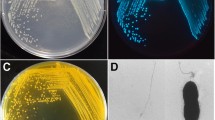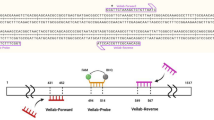Abstract
Acute hepatopancreatic necrosis disease (AHPND) is a serious disease in shrimp and results in considerable losses for the shrimp aquaculture industry. The etiologic agent of AHPND has recently been identified as a unique strain of Vibrio parahaemolyticus: One that is different from human pathogenic V. parahaemolyticus strains. In this study, two sets of primers (LAMP-A2 and LAMP-A3) were developed and validated for use in a LAMP assay to specifically identify V. parahaemolyticus causing AHPND (V. parahaemolyticus AHPND). LAMP-A2 and LAMP-A3 detected all 33 V. parahaemolyticus AHPND isolates except the non-V. parahaemolyticus AHPND isolates and 19 other closely related bacterial species. In pure culture and in spiked shrimp experiments, the LAMP assay was superior to PCR for the detection of V. parahaemolyticus AHPND. In pure cultures, the detection limit of LAMP-A3 was 53 CFU/ml or 0.1 CFU per reaction (10× lower than LAMP-A2), whereas in spiked shrimp experiments, the detection limit was 4.4 × 105 CFU/ml or 8.8 × 102 CFU per reaction. Further testing of 24 post-larvae, shrimp, sediment and water samples collected from a shrimp farm revealed that V. parahaemolyticus AHPND was detected mostly in the sediment samples. Taken together, the results suggested that the LAMP-A3-based LAMP assay, but not LAMP-A2 or PCR, was suitable for the identification of V. parahaemolyticus AHPND in shrimp aquaculture.
Similar content being viewed by others
References
Bej AK, Patterson DP, Brasher CW, Vickery MCL, Jones DD, Kaysner CA (1999) Detection of total and hemolysin-producing Vibrio parahaemolyticus in shellfish using multiplex PCR amplification of tl, tdh and trh. J Microbiol Methods 36:215–225
Chen S, Ge B (2010) Development of toxR-based loop-mediated isothermal amplification assay for detecting Vibrio parahaemolyticus. BMC Microbiol 10:41
Han F, Ge B (2008) Evaluation of a loop-mediated isothermal amplification assay for detecting Vibrio vulnificus in raw oysters. Foodborne Pathog Dis 5:311–320
Hara-Kudo Y, Yoshino M, Kojima T, Ikedo M (2005) Loop-mediated isothermal amplification for the rapid detection of Salmonella. FEMS Microbiol Lett 253:155–161
Joshi J, Srisala J, Truong VH, Chen IT, Nuangsaeng B, Suthienkul O, Lo CF, Flegel TW, Sritunyalucksana K, Thitamadee D (2014) Variation in Vibrio parahaemolyticus isolates from a single thai shrimp farm experiencing an outbreak of acute hepatopancreatic necrosis disease (AHPND). Aquaculture 428–429:297–302
Kim YB, Okuda J, Matsumoto C, Takahashi N, Hashimoto S, Nishibuchi M (1999) Identification of Vibrio parahaemolyticus strains at the species level by PCR targeted to the toxR gene. J Clin Microbiol 37:1173–1177
Lau YL, Meganathan P, Sonaimuthu P, Thiruvengadam G, Nissapatorn V, Chen Y (2010) Specific, sensitive, and rapid diagnosis of active toxoplasmosis by a loop-mediated isothermal amplification method using blood samples from patients. J Clin Microbiol 48:3698–3702
Nishibuchi M, Kaper JB (1995) Thermostable direct hemolysin gene of Vibrio parahaemolyticus: a virulence gene acquired by a marine bacterium. Infect Immun 63:2093–2099
Srisuk C, Chaivisuthangkura P, Rukpratanporn S, Longyant S, Sridulyakul P, Sithigorngul P (2010) Rapid and sensitive detection of Vibrio cholerae by loop-mediated isothermal amplification targeted to the gene of outer membrane protein ompW. Lett Appl Microbiol 50:36–42
Tran L, Nunan L, Redman RM, Mohney LL, Pantoja CR, Fitzsimmons K, Lightner DV (2013) Determination of the infectious nature of the agent of acute hepatopancreatic necrosis syndrome affecting penaeid shrimp. Dis Aquat Org 105:45–55
Yamazaki W, Ishibashi M, Kawahara R, Inoue K (2008) Development of a loop-mediated isothermal amplification assay for sensitive and rapid detection of Vibrio parahaemolyticus. BMC Microbiol 8:163–169
Yamazaki W, Taguchi M, Kawai T, Kawatsu K, Sakata J, Inoue K, Misawa N (2009) Comparison of loop-mediated isothermal amplification assay and conventional culture methods for detection of Campylobacter jejuni and Campylobacter coli in naturally contaminated chicken meat samples. Appl Environ Microbiol 75:1597–1603
Yamazaki W, Kumeda Y, Misawa N, Nakaguchi Y, Nishibuchi M (2010) Development of a loop-mediated isothermal amplification assay for sensitive and rapid detection of the tdh and trh genes in Vibrio parahaemolyticus and related Vibrio specie. Appl Environ Microbiol 76:820–828
Yeung PMS, Boor KJ (2004) Epidemiology, pathogenesis, and prevention of foodborne Vibrio parahaemolyticus infections. Foodborne Pathog Dis 1:74–88
Yingkajorn M, Mitraparp-arthorn P, Nuanualsuwan S, Poomwised R, Kongchuay K, Khamhaeng N, Vuddhakul V (2014) Prevalence and quantification of pathogenic Vibrio parahaemolyticus during shrimp culture in Thailand. Dis Aquat Org 112:103–111
Acknowledgments
This work was supported by the Prince of Songkla University and in part, by Kakenhi Grant-in-Aid for Scientific Research (KAKENHI 24249038) from the Japan Society for the Promotion of Sciences and grant-in-aid of the Ministry of Health, Labor and Welfare, Japan.
The authors thank Sonkhla shrimp farm for providing various samples. We also thank Brian Hodgsen for reading and commenting on this manuscript.
Author information
Authors and Affiliations
Corresponding author
Rights and permissions
About this article
Cite this article
Kongrueng, J., Tansila, N., Mitraparp-arthorn, P. et al. LAMP assay to detect Vibrio parahaemolyticus causing acute hepatopancreatic necrosis disease in shrimp. Aquacult Int 23, 1179–1188 (2015). https://doi.org/10.1007/s10499-014-9874-3
Received:
Accepted:
Published:
Issue Date:
DOI: https://doi.org/10.1007/s10499-014-9874-3




